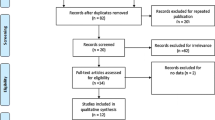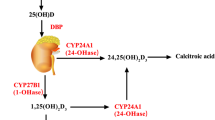Abstract
The effect of vitamin D receptor (VDR) gene polymorphisms on Parkinson’s disease (PD) has recently gained interest. However, evidence on this relationship is controversial. We searched PubMed, EMBASE and the Cochrane Library database targeted all studies that evaluated VDR gene polymorphisms and PD up to April 2,014. A meta-analysis was conducted on the association between VDR ApaI, BsmI, TaqI and FokI polymorphisms and PD using (1) allelic contrast, (2) dominant, (3) recessive, and (4) additive models. A total of five relevant studies involving PD patients (n = 1,266) and controls (n = 1,649) were included in the analysis. There was a significant association between FokI polymorphism and PD. In the pooled allelic analysis, the F allele was associated with increased risk of PD (OR 1.41, 95 % CI 1.14–1.75). In the genotype analysis, FF + Ff versus ff showed a significant association with PD in the dominant model (OR 2.32, 95 % CI 1.49–3.61, P = 0.0002). FF versus ff showed a significant association with PD in the additive model (OR 2.45, 95 % CI 1.52–3.93, P = 0.0002). There was also a statistically significant association between VDR BsmI polymorphisms in the recessive model, BB versus Bb + bb showed a significant increased risk of PD (OR 1.37, 95 % CI 1.01–1.87, P = 0.04). No significant associations were observed between VDR ApaI and TaqI polymorphisms and PD. To sum up, VDR BsmI and FokI polymorphisms were associated with increased risk of PD.





Similar content being viewed by others
References
Thomas B, Beal MF (2007) Parkinson’s disease. Hum Mol Genet 16(2):R183–R194
Hancock DB, Martin ER, Vance JM, Scott WK (2008) Nitric oxide synthase genes and their interactions with environmental factors in Parkinson’s disease. Neurogenetics 9(4):249–262
Liu GJ, Feng RN, Luo C, Bi S (2010) Lack of association between interleukin-1 alpha, beta polymorphisms and Parkinson’s disease. Neurosci Lett 480(2):158–161
McCulloch CC, Kay DM, Factor SA, Samii A, Nutt JG, Higgins DS, Griffith A, Roberts JW, Leis BC, Montimurro JS et al (2008) Exploring gene-environment interactions in Parkinson’s disease. Hum Genet 123(3):257–265
Mizuta I, Tsunoda T, Satake W, Nakabayashi Y, Watanabe M, Takeda A, Hasegawa K, Nakashima K, Yamamoto M, Hattori N et al (2008) Calbindin 1, fibroblast growth factor 20, and alpha-synuclein in sporadic Parkinson’s disease. Hum Genet 124(1):89–94
van der Walt JM, Noureddine MA, Kittappa R, Hauser MA, Scott WK, McKay R, Zhang F, Stajich JM, Fujiwara K, Scott BL et al (2004) Martin, Fibroblast growth factor 20 polymorphisms and haplotypes strongly influence risk of Parkinson disease. Am J Hum Genet 74(6):1121–1127
Evatt ML, Delong MR, Khazai N, Rosen A, Triche S, Tangpricha V (2008) Prevalence of vitamin d insufficiency in patients with Parkinson disease and Alzheimer disease. Arch Neurol 65(10):1348–1352
Knekt P, Kilkkinen A, Rissanen H, Marniemi J, Sääksjärvi K, Heliövaara M (2010) Serum vitamin D and the risk of Parkinson disease. Arch Neurol 67(7):808–811
Smolders J, Peelen E, Thewissen M, Menheere P, Tervaert JW, Hupperts R, Damoiseaux J (2009) The relevance of vitamin D receptor gene polymorphisms for vitamin D research in multiple sclerosis. Autoimmun Rev 8(7):621–626
Garcion E, Wion-Barbot N, Montero-Menei CN, Berger F, Wion D (2002) New clues about vitamin D functions in the nervous system. Trends Endocrinol Metab 13(3):100–105
Eyles DW, Smith S, Kinobe R, Hewison M, McGrath JJ (2005) Distribution of the vitamin D receptor and 1 alpha-hydroxylase in human brain. J Chem Neuroanat 29(1):21–30
Lambrinoudaki I, Patikas E, Kaparos G, Armeni E, Rizos D, Thoda P, Alexandrou A, Antoniou A, Tsivgoulis G, Gatzonis S et al (2013) Vitamin D receptor Bsm1 polymorphism, calcium metabolism and bone mineral density in patients with multiple sclerosis: a pilot study. Neurol Sci 34(8):1433–1439
Wang L, Hara K, Van Baaren JM, Price JC, Beecham GW, Gallins PJ, Whitehead PL, Wang G, Lu C, Slifer MA et al (2012) Vitamin D receptor and Alzheimer’s disease: a genetic and functional study. Neurobiol Aging 33(8):1844.e1–1844.e9
Butler MW, Burt A, Edwards TL, Zuchner S, Scott WK, Martin ER, Vance JM, Wang L (2011) Vitamin D receptor gene as a candidate gene for Parkinson disease. Ann Hum Genet 75(2):201–210
Lv Z, Tang B, Sun Q, Yan X, Guo J (2013) Association study between vitamin d receptor gene polymorphisms and patients with Parkinson disease in Chinese Han population. Int J Neurosci 123(1):60–64
Suzuki M, Yoshioka M, Hashimoto M, Murakami M, Noya M, Takahashi D, Urashima M (2013) Randomized, double-blind, placebo-controlled trial of vitamin D supplementation in Parkinson disease. Am J Clin Nutr 97(5):1004–1013
Zhang ZT, He YC, Ma XJ, Li DY, Lu GC (2014) Association between vitamin D receptor gene polymorphisms and susceptibility to Parkinson’s disease : a meta-analysis. Neurosci Lett 578(2):122–127
Lee YH, Kim JH, Song GG (2014) Vitamin D receptor polymorphisms and susceptibility to Parkinson’s disease and Alzheimer’s disease: a meta-analysis. Neurol Sci. doi:10.1007/s10072-014-1868-4 [Epub ahead of print]
Stroup DF, Berlin JA, Morton SC, Olkin I, Williamson GD, Rennie D, Moher D, Becker BJ, Sipe TA, Thacker SB (2000) Meta-analysis of observational studies in epidemiology: a proposal for reporting. Meta- analysis Of Observational Studies in Epidemiology (MOOSE) group. JAMA 283(15):2008–2012
Hoehn MM, Yahr MD (1967) Parkinsonism: onset, progression and mortality. Neurology 17(5):427–442
Goetz CG, Tilley BC, Shaftman SR, Stebbins GT, Fahn S, Martinez-Martin P, Poewe W, Sampaio C, Stern MB, Dodel R et al (2008) Movement Disorder Society-sponsored revision of the Unified Parkinson’s Disease Rating Scale (MDS-UPDRS): scale presentation and clinimetric testing results. Mov Disord 23(15):2129–2170
Duckitt K, Harrington D (2005) Risk factors for pre-eclampsia at antenatal booking: systematic review of controlled studies. BMJ 330(7491):565
Han X, Xue L, Li Y, Chen B, Xie A (2012) Vitamin D receptor gene polymorphism and its association with Parkinson’s disease in Chinese Han population. Neurosci Lett 525(1):29–33
Kim JS, Kim YI, Song C, Yoon I, Park JW, Choi YB, Kim HT, Lee KS (2005) Association of vitamin D receptor gene polymorphism and Parkinson’s disease in Koreans. J Korean Med Sci 20(3):495–498
Lin CH, Chen KH, Chen ML, Lin HI, Wu RM (2014) Vitamin D receptor genetic variants and Parkinson’s disease in a Taiwanese population. Neurobiol Aging 35(5):1212.e11–1212.e13
Petersen MS, Bech S, Christiansen DH, Schmedes AV, Halling J (2014) The role of vitamin D levels and vitamin D receptor polymorphism on Parkinson’s disease in the Faroe Islands. Neurosci Lett 561:74–79
Suzuki M, Yoshioka M, Hashimoto M, Murakami M, Kawasaki K, Noya M, Takahashi D, Urashima M (2012) 25-hydroxyvitamin D, vitamin D receptor gene polymorphisms, and severity of Parkinson’s disease. Mov Disord 27(2):264–271
Török R, Török N, Szalardy L, Plangar I, Szolnoki Z, Somogyvari F, Vecsei L, Klivenyi P (2013) Association of vitamin D receptor gene polymorphisms and Parkinson’s disease in Hungarians. Neurosci Lett 551:70–74
Allen PJ, Feigin A (2014) Gene-based therapies in Parkinson’s Disease. Neurotherapeutics 11(1):60–67
Deluca HF, Cantorna MT (2001) Vitamin D: its role and uses in immunology. FASEB J 15(14):2579–2585Ref. 30
Fang Y, van Meurs JB, d’Alesio A, Jhamai M, Zhao H, Rivadeneira F, Hofman A, van Leeuwen JP, Jehan F, Pols HA et al (2005) Promoter and 3′-untranslated-region haplotypes in the vitamin d receptor gene predispose to osteoporotic fracture: the rotterdam study. Am J Hum Genet 77(5):807–823
Jurutka PW, Remus LS, Whitfield GK, Thompson PD, Hsieh JC, Zitzer H, Tavakkoli P, Galligan MA, Dang HT, Haussler CA et al (2000) the polymorphic n terminus in human vitamin d receptor isoforms influences transcriptional activity by modulating interaction with transcription factor iib. Mol Endocrinol 14(3):401–420
Uitterlinden AG, Fang Y, Van Meurs JB, Pols HA, Van Leeuwen JP (2004) Genetics and biology of vitamin D receptor polymorphisms. Gene 338(2):143–156
Jurutka PW, Whitfield GK, Hsieh JC, Thompson PD, Haussler CA, Haussler MR (2001) Molecular nature of the vitamin D receptor and its role in regulation of gene expression. Rev Endocr Metab Disord 2(2):203–216
Calne DB, Snow BJ, Lee C (1992) Criteria for diagnosing Parkinson’s disease. Ann Neurol 32:S125–S127
Hughes AJ, Daniel SE, Kilford L, Lees AJ (1992) Accuracy of clinical diagnosis of idiopathic Parkinson’s disease: a clinico-pathological study of 100 cases. J Neurol Neurosurg Psychiatry 55(3):181–184
Hughes AJ, Ben-Shlomo Y, Daniel SE, Lees AJ (1992) What features improve the accuracy of clinical diagnosis in Parkinson’s disease: a clinicopathologic study. Neurology 42(6):1142–1146
Acknowledgments
This work was supported by the Harbin Special Funds for Research of Scientific and Technological Innovative Talents (No. 2011RFQYS092) and Innovative Foundation of the Harbin Medical University (HCXS2010014). The following authors contributed substantially to conception and design (SB, HPQ, SRD, CLL), data collection (SB, CLL, HPQ, LW, XXF, SRD), and analyses and interpretation of data (SB, SQW, CLL, HPQ, LW, XXF, SRD). All authors revised the paper critically for important intellectual content and gave final approval of the version to be published.
Conflict of interest
The authors report no conflict of interest.
Author information
Authors and Affiliations
Corresponding author
Electronic supplementary material
Below is the link to the electronic supplementary material.
Rights and permissions
About this article
Cite this article
Li, C., Qi, H., Wei, S. et al. Vitamin D receptor gene polymorphisms and the risk of Parkinson’s disease. Neurol Sci 36, 247–255 (2015). https://doi.org/10.1007/s10072-014-1928-9
Received:
Accepted:
Published:
Issue Date:
DOI: https://doi.org/10.1007/s10072-014-1928-9




